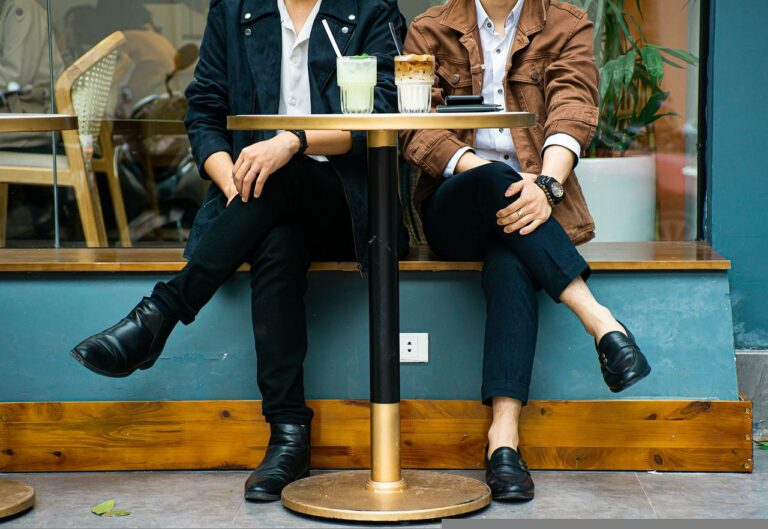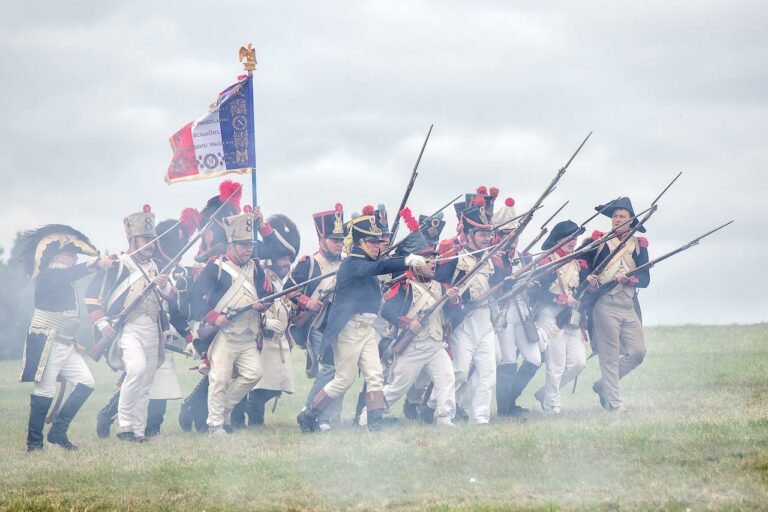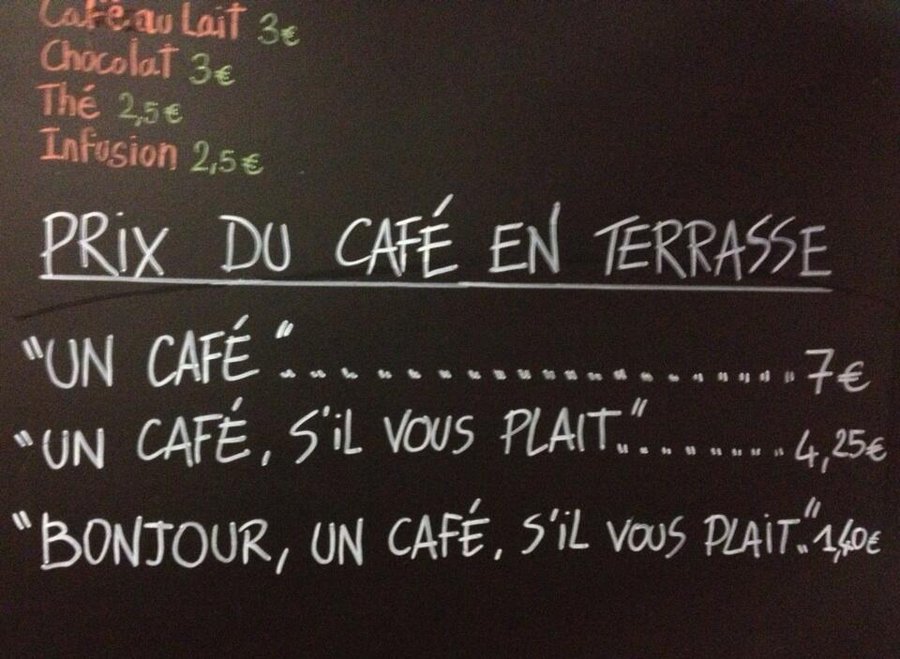What is this mysterious French question? On se prend un petit jus ? (Shall we have a little juice?)
A juice of what, first of all? Apple, grape, apricot? A squeezed orange?
But not at all! Jus is one of the many words used to talk about coffee.
And the question On se prend un petit jus ? is a very common way to ask your lover, friend, acquaintance, colleague… to stop for a coffee in a bar.
In France, having a little coffee, on a terrace, in the sun, is part of the simple joys of everyday life. And as in all the countries that have this coffee culture, the lexicon used is incredibly rich and varied.
In this article, I’m going to give you some pointers to help you when it comes time to order a coffee in France.
But first, let’s clear up a few riddles about the places where you can have a coffee in France:
- brasseries,
- cafés,
- bistrots,
- troquets,
- snack bars
✔️ Ecoute & lis…
Voilà plus de 4 siècles que le café est arrivé en Europe. Cette boisson énergisante a rapidement été appréciée au fil du temps, tant pour ses propriétés que pour son caractère social. On partage volontiers un café en discutant, et ce, depuis toujours. Et c’est probablement cet aspect, lié au partage et à l’échange qui l’a parfois rendu controverse…
Ces petits grains, si anodins pour nous aujourd’hui, ont longtemps été au cœur de polémiques, d’interdictions, entraînant même parfois des révoltes au fil de l’histoire, aussi bien dans leur pays d’origine qu’en France. C’est seulement au prix d’un long périple, historique et géographique, que le café est devenu la boisson que l’on connaît aujourd’hui.
Source : Maison Du Café
Brasseries, cafés, bistrots, troquets, snack bars… Drinking places in France
There are so many options in France, so many terms for these places where you can have a coffee that it can be confusing!
Brasseries, cafés, bistros, troquets, snack bars… All of them are drinking establishments, the official and administrative name to describe places where you can consume drinks, alcoholic or not.
So how to choose and what is the difference?

La brasserie
Originally, une brasserie was an establishment where beer was brewed, i.e., it was made on the premises.
Over time, breweries have evolved into a full-fledged culinary experience, offering continuous service from early morning until late evening, with a wide selection of dishes, from mimosa eggs to lobster.
Drinking coffee in a brasserie?
Of course, it is possible to drink a coffee in a brasserie, but the waiters will probably refuse to serve you at meal times, preferring to reserve their tables for customers who would like to have lunch or dinner..
Do you like learning French with videos?
Receive our free video newsletter every Friday in your e-mail box. You will get 3 “Tips & Tricks” on grammar, vocabulary, phonetics or French culture.
👉👉 Sign up now!
Le café
In a café, we mainly serve hot drinks and occasionally snacks, small things to eat:
- croque-monsieur, sandwich, salad, omelet for the salty lovers
- apple pie, lemon pie, caramel cream for the greedy ones.
One comes to a café alone or accompanied to have breakfast or a bite to eat after work and relax for a while.
Drinking coffee in a café?
Doesn’t that make sense? Of course it does!
Le bistrot
A little history of the French bistro…
The name bistro goes back to the beginning of the 19th century. At that time, only alcohol was served. It also had another name: l’Assommoir, which is also the title of a novel by Emile Zola, an author who in all his work described the miseries of the people and the emerging working class, in the 19th century.
The verb assommer means to hit someone on the head until he loses consciousness. The bistros, the assommoirs were these cheap establishments where the drinkers drowned their worries in bad wine, alcohol or absinthe.
A few decades later, the Auvergnats (the inhabitants of the Auvergne region) started to serve snacks (little things to eat): ham and dried meat to accompany the wine they served to their customers.
And, a small revolution, the Auvergnats also started to accept women in their bistros!
Maybe that’s why Georges Brassens, a famous French chansonnier, dedicated a song to them: Chanson pour l’Auvergnat!
There are several theories about the exact origins of the name bistro as explained by the author Luc Bilh-Villette in his essay “From Taverns to Bistros, a History of Cafés“.
A popular theory is that the word bistro could come from Russian. In Russian, bistrot means fast. A memory left by the Russian soldiers who had settled in France in 1814 after the battle of Paris, a battle that marked the end of Napoleon Bonaparte’s empire.
The story goes that, in order to pressure the waiters who served them too slowly for their taste, the Russian soldiers repeated “bistrot, bistrot“… Quick, quick!

Drinking coffee in a bistro?
Yes, you can have a coffee in a bistro. Bistrot is a more familiar term for café or bar. The bistro is also a no-frills, unpretentious and popular place where you can enjoy drinks… alcoholic or not!
You can also eat there, of course, most often dishes with simple flavors, sometimes specialties of the region.
From the bistro without fuss to the Bistronomie
Do you know the word Gastronomie?
Well, in the last few years, a new term and concept has appeared in France: Bistronomie. It is a word made of two words: bistrot + gastronomie = bistronomie.
The concept of bistronomy was developed by the new generations of chefs who felt frustrated by the rigid codes of the starred establishments where they worked.
They then left the palaces to open their own restaurants and offer dishes in their image, a simple but succulent cuisine, classic but inventive, with fresh and quality products, served in a friendly setting.
But I digress… You can probably sip a little coffee at a Bistronome!
But he will undoubtedly prefer that you come to his establishment to discover all the culinary wonders he has prepared for you… without fuss!
Le troquet
The troquet is a familiar, popular, slightly old-fashioned term for a place where you drink: a coffee or… something else!
Le snack bar
A snack bar is a place where you can buy snacks like pizzas, kebabs, burgers…
Some snack bars have tables and chairs for on-site consumption.
Others only offer snacks to take away. Most snack bars are located near tourist areas or in areas with a high concentration of students or offices.
Can you drink coffee in a snack bar?
Absolutely! But most often it will be served in a paper cup. Not a great way to enjoy the taste of coffee.
The French coffee lexicon
You want an espresso, so you can say: Bonjour, un café s’il vous plaît ! (Coffee please!)

It’s very simple: if you order a coffee, the waiter or waitress will bring you an espresso. But there are other ways to say it:
- un expresso,
- un petit noir,
- un kawa…
Kawa comes from Arabic, it’s a colloquial term used in France for… Coffee! You can also order un double expresso, un grand noir, un grand café.
And of course, if you are like me and you like very strong coffee, just an inch at the bottom of the cup and black as tar, then you will say: un café serré (a strong coffee).
On the other hand, you can order un café allongé (a long coffee) if you prefer it lighter.
Finally, the most diluted version, with little coffee and a lot of water, is the… café américain 🙈 American coffee. The French have coined a not-so-nice expression for American coffee: they call it le jus de chaussettes (the juice of socks)… Would you want to drink that?
If drinking coffee keeps you awake at night, you can order un déca (a decaf), for café décaféiné (decaffeinated coffee).
Now let’s add a little milk in the French coffee
An espresso with a splash of milk is called une noisette (a hazelnut). Which you can also order as un petit crème.
And of course, un grand crème is the same thing, but with a double shot.
And finally, the famous Cappuccino…
But our Italian neighbors are champions in this field and I wouldn’t want to steal their thunder. I prefer to drink cappuccino in Italy!
You can also have a coffee with a bit of liquor, also from Italy, this caffè corretto is available with different alcohols: a little grappa, sambuco, brandy, etc. is poured into the cup!
Finally… After a good meal, rich and copious, a banquet like you see in the Asterix comics, after a good meal, you can without derogation order a coffee, then un pousse-café (a pousse-café) :
- a schnapps (French word !),
- a cognac,
- an armagnac,
- a pear…
In short, a brandy, a strong alcohol.
Le café gourmand (the gourmet coffee)
You may also see on the menus of French restaurants this rather special dessert: le café gourmand…
There is no universal recipe for the café gourmand, each restaurant adapts it as it wishes. But the common point between all of them is the presence of :
- a coffee
- small desserts in mini versions, usually 5 or 6 different desserts.
Small desserts that you can enjoy while sipping your coffee 😀
So, there you have it. A little lesson in French coffee culture.
The next time you’re in a brasserie or café in France, be sure to order like a pro and enjoy your café gourmand with all the trimmings!
Articles that might interest you:
- Why do French people speak English so badly?
- Grasse (the French city) World Capital of Perfumes
- French Bastille Day: July 14th
- Who are the most popular French YouTubers?
- How the bag company “I speak fluent french” has released a new collection of bags?
- French Tipping Etiquette: 10 Things Everyone Should Know
- The French and their love of coffee
- Is the French manicure really from France?
- How to understand the gestures and mimics of the French?
- French Gastronomy




3 thoughts on “The French and their love of coffee”
Comments are closed.